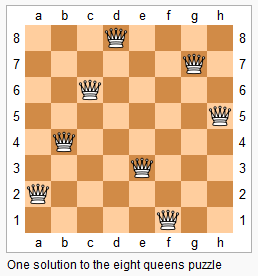The n-queens puzzle is the problem of placing n queens on an n×n chessboard such that no two queens attack each other.

Given an integer n, return all distinct solutions to the n-queens puzzle.
Each solution contains a distinct board configuration of the n-queens' placement, where 'Q' and '.' both indicate a queen and an empty space respectively.
Example:
Input: 4 Output: [ [".Q..", // Solution 1 "...Q", "Q...", "..Q."], ["..Q.", // Solution 2 "Q...", "...Q", ".Q.."] ] Explanation: There exist two distinct solutions to the 4-queens puzzle as shown above.
AC code:
class Solution {
public:
vector<vector<string>> solveNQueens(int n) {
int res = 0;
vector<vector<string>> v;
vector<string> nqueens(n, string(n, '.'));
solve(v, nqueens, n, 0);
return v;
}
void solve(vector<vector<string>>& v, vector<string>& nqueens, int n, int row) {
if (row == n) {
v.push_back(nqueens);
return;
}
for (int col = 0; col < n; ++col) {
if (judge(nqueens, n, row, col)) {
nqueens[row][col] = 'Q';
solve(v, nqueens, n, row+1);
nqueens[row][col] = '.';
}
}
}
bool judge(vector<string> nqueens, int n, int x, int y) {
// up and down
for (int i = 0; i < n && i != x; ++i) {
if (nqueens[i][y] == 'Q') return false;
}
// right and left
for (int i = 0; i < n && i != y; ++i) {
if (nqueens[x][i] == 'Q') return false;
}
// left up
for (int i = x-1, j = y-1; i >= 0 && j >= 0; --i, --j) {
if (nqueens[i][j] == 'Q') return false;
}
// right up
for (int i = x-1, j = y+1; i >= 0 && j < n; --i, ++j) {
if (nqueens[i][j] == 'Q') return false;
}
return true;
}
};Runtime: 32 ms, faster than 8.09% of C++ online submissions for N-Queens.
























 被折叠的 条评论
为什么被折叠?
被折叠的 条评论
为什么被折叠?








